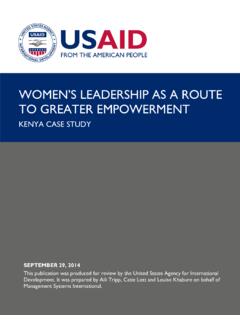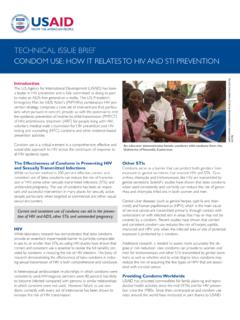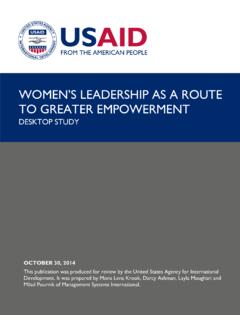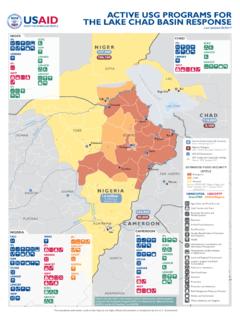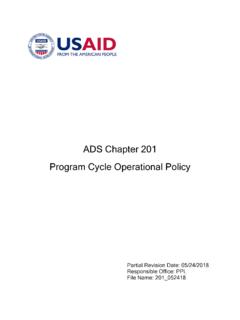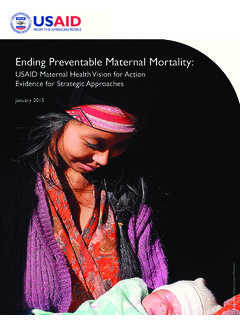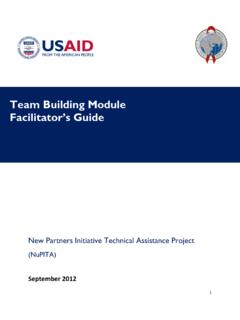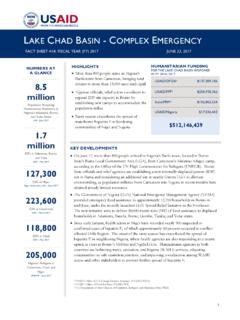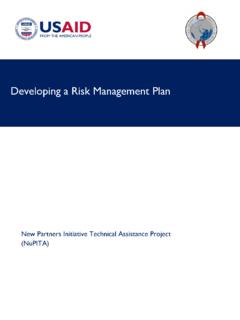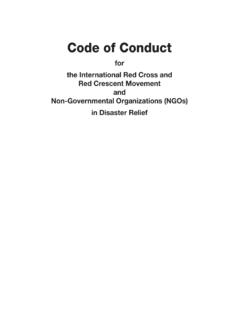Transcription of Field Operations Guide - U.S. Agency for International ...
1 Field Operations Guide For Disaster Assessment and Response Agency for International Development Bureau for Democracy, Conflict, and Humanitarian Assistance Office of Foreign Disaster Assistance In cooperation with and produced by The USDA Forest Service International Programs Disaster Assistance Support Program Version September 2005. Emergency Indicators and Minimum Standards Malnutrition Emergency Definitions Global Acute Malnutrition (GAM) = Severe Acute Malnutrition (SAM) +. Moderate Acute Malnutrition (MAM). GAM for <5 age group Z-Score <-2 MUAC < cm WFH/WFL <80%. SAM for <5 age group Z-Score <-3 MUAC < cm WFH/WFL <70%. MAM for <5 age group Z-Score >-3 and <-2 MUAC > and < cm WFH/WFL >70% and <80%.
2 See section D of chapter III, Interpretation of Malnutrition Rates and Corresponding Actions, for malnutrition indicators. Mortality Rate Emergency Indicators Crude Mortality Rate (CMR): single most important indicator of serious stress in affected populations CMR = deaths/10,000/day: emergency phase <1 = Under control >1 = Serious condition >2 = Out of control >4 = Major catastrophe Mortality rate for <5 age group 1 = Normal in a developing country <2 = Emergency phase: under control >2 = Emergency phase: in serious trouble >3 = Emergency phase: out of control Minimum Water Requirements Minimum maintenance = 15 liters/person/day Feeding centers = 30 liters/inpatient/day Health centers and hospitals = 40 60 liters/inpatient/day 1 tap stand/250 people not >100m from users A large quantity of reasonably safe water is preferable to a small amount of pure water Minimum Food Requirements Minimum maintenance = 2,100 Kcals/person/day Minimum Shelter/Space Requirements Minimum shelter space = m2/person Minimum total site area = 45 m2/person for temporary planned or self- settled camps Minimum Sanitation Requirements At least 1 toilet for every 20 persons Maximum of 1 minute walk from dwelling to toilet ( 6m and 50m).
3 CONTENTS. Introduction ..xvii Policy Guidelines ..xix Chapter I: General Responsibilities and Information ..I-1. A. Individual Team Member Checklist ..I-2. 1. Personal Items and Related Tips ..I-2. 2. Optional Items (Bring at Your Own Risk) ..I-3. 3. Personal Health Items and Medical Tips ..I-3. 4. OFDA-Provided Items ..I-4. 5. Information To Be Left With OFDA/W ..I-4. B. Team Support Checklist ..I-4. C. Documentation ..I-5. 1. General ..I-5. 2. Types of Documentation ..I-6. D. Accountability and Liability ..I-6. 1. Equipment ..I-6. 2. Accountability ..I-7. 3. Liability ..I-8. E. Administration ..I-8. 1. Time Records ..I-8. 2. Per Diem and Vouchers ..I-9. 3. Procurement and Contracting ..I-9. F.
4 Safety and Security ..I-9. 1. Safety and Security Checklist ..I-10. G. Personal Health and Critical-Incident Stress ..I-11. 1. Briefings ..I-12. 2. Managing Culture Shock ..I-12. 3. Critical-Incident Stress ..I-12. 4. How Team Members May Be Affected by Stress During Disaster Operations ..I-13. 5. How To Minimize Stress During a Disaster Operation ..I-14. i FOG Version Chapter II: Assessments ..II-1. A. Introduction ..II-2. B. Purpose of an Initial Assessment ..II-2. C. Assessment Team Composition ..II-4. D. Assessment Recommendations and Their Impact on Recovery ..II-4. E. Keys to a Successful Assessment ..II-5. 1. Identify the Users ..II-5. 2. Identify the Information Needed To Plan Specific Programs.
5 II-5. 3. Consider the Format ..II-6. 4. Consider the Timing of the Assessment ..II-6. 5. Determine the Best Places To Obtain Information ..II-6. 6. Distinguish Between Emergency and Chronic Needs II-6. 7. Assess Needs and Vulnerabilities in Relation to Capacities ..II-7. 8. Use Recognized Terminology, Standards, and Procedures ..II-8. F. Types of Assessments ..II-8. 1. Situation (Disaster) Assessment ..II-8. 2. Needs Assessment ..II-9. 3. Environmental Impact Assessment ..II-10. G. Elements of an Assessment ..II-11. 1. Preparedness Planning ..II-11. 2. Survey and Data Collection ..II-12. 3. Interpretation ..II-12. 4. Forecasting ..II-12. 5. Reporting ..II-12. 6. Monitoring ..II-12. H. Data Collection.
6 II-13. 1. Data Collection Considerations ..II-13. 2. Data Collection Methods ..II-14. I. OFDA Assessment Cable Reporting Formats ..II-15. 1. Disaster Cable Format Considerations ..II-15. 2. Who Should Get the Cable ..II-16. ii FOG Version 3. Disaster Cable Contents ..II-17. a. Subject ..II-17. b. References ..II-17. c. Summary ..II-17. d. General Situation ..II-18. e. Food and Food Distribution ..II-19. f. Health and Nutrition ..II-19. g. Water and Sanitation ..II-20. h. Shelter ..II-21. i. Capability and Capacity ..II-22. j. Coordination ..II-22. k. Recommendations ..II-22. J. Assessment Checklists ..II-22. 1. Introduction ..II-22. 2. Victims/Displaced Population Profile ..II-23. a. General Characteristics.
7 II-23. b. Capacities ..II-23. c. Displaced Populations ..II-24. d. Physical Assets ..II-24. 3. Food ..II-25. a. Baseline Data ..II-25. b. Effect of the Event on Food ..II-25. c. Food Availability ..II-26. d. Distribution Systems ..II-27. e. Social and Market Impact of Food Aid ..II-27. f. Other ..II-27. 4. Nutrition ..II-28. a. Nutritional Status ..II-28. b. Public Health-Related Risk of Malnutrition ..II-29. c. Care-Related Risk of Malnutrition ..II-29. d. Food Access-Related Risk of Malnutrition ..II-30. e. Nutrition Interventions ..II-30. 5. Health ..II-31. a. Health and Demographic Information ..II-31. b. HIV/AIDS ..II-32. c. Health System Capabilities ..II-32. d. Local Health Programs ..II-33.
8 E. Health Information/Surveillance Systems ..II-34. f. Cultural and Social Health Factors ..II-35. g. Environmental Health Factors ..II-35. 6. Water ..II-36. a. Displaced Population Situation ..II-36. b. Water System Disruption ..II-36. iii FOG Version 7. Sanitation ..II-37. a. Displaced Population Situation ..II-37. b. Nondisplaced Population Situation ..II-37. 8. Shelter and Settlements ..II-38. a. Establishing Context ..II-38. b. Identifying Impacts, Resources, and Opportunities ..II-39. 9. Agriculture and Livestock ..II-42. a. Baseline Data ..II-42. b. Effect of the Event on Agriculture ..II-43. c. Effect of the Event on Livestock ..II-44. d. Agricultural Production Capabilities ..II-45. e.
9 Other ..II-46. 10. Search and Rescue ..II-46. 11. Logistics ..II-47. a. Airports ..II-47. b. Civil Aviation ..II-48. c. Alternative Aircraft ..II-49. d. Seaports ..II-49. e. Transfer Points ..II-51. f. Trucking ..II-51. g. Railroads ..II-52. h. Warehousing ..II-52. 12. Infrastructure ..II-54. a. Communications ..II-54. b. Electric Power ..II-56. c. Community Water Supply and Wastewater Treatment/Disposal ..II-57. d. Hydraulic Structures (Dams, Levees, Irrigation Canals, Hydropower Facilities) ..II-58. e. Roads and Bridges ..II-59. Chapter III: Information on Populations at Risk ..III-1. A. Introduction ..III-2. B. Immediate Response ..III-2. 1. Protection of Populations at Risk ..III-2. a. Protection Problems.
10 III-3. b. Possible Actions ..III-4. 2. Organizational Considerations for Displaced Persons ..III-6. 3. Material Assistance ..III-6. iv FOG Version C. Water ..III-8. 1. General ..III-8. a. Evaluating Water Sources ..III-9. b. Water System Considerations ..III-10. 2. Determining Water Needs ..III-11. a. Quantity ..III-11. b. Quality ..III-13. 3. Immediate Response ..III-15. 4. Water Source ..III-17. a. Freshwater Sources ..III-17. (1) Surface Water ..III-17. (2) Ground Water ..III-17. (3) Rainwater ..III-18. b. Seawater ..III-19. c. Water Source Considerations ..III-19. 5. Storage ..III-22. 6. Distribution ..III-23. 7. Treatment ..III-24. a. Storage ..III-25. b. Sand Filtration ..III-25. c. Coagulation and Flocculation.
